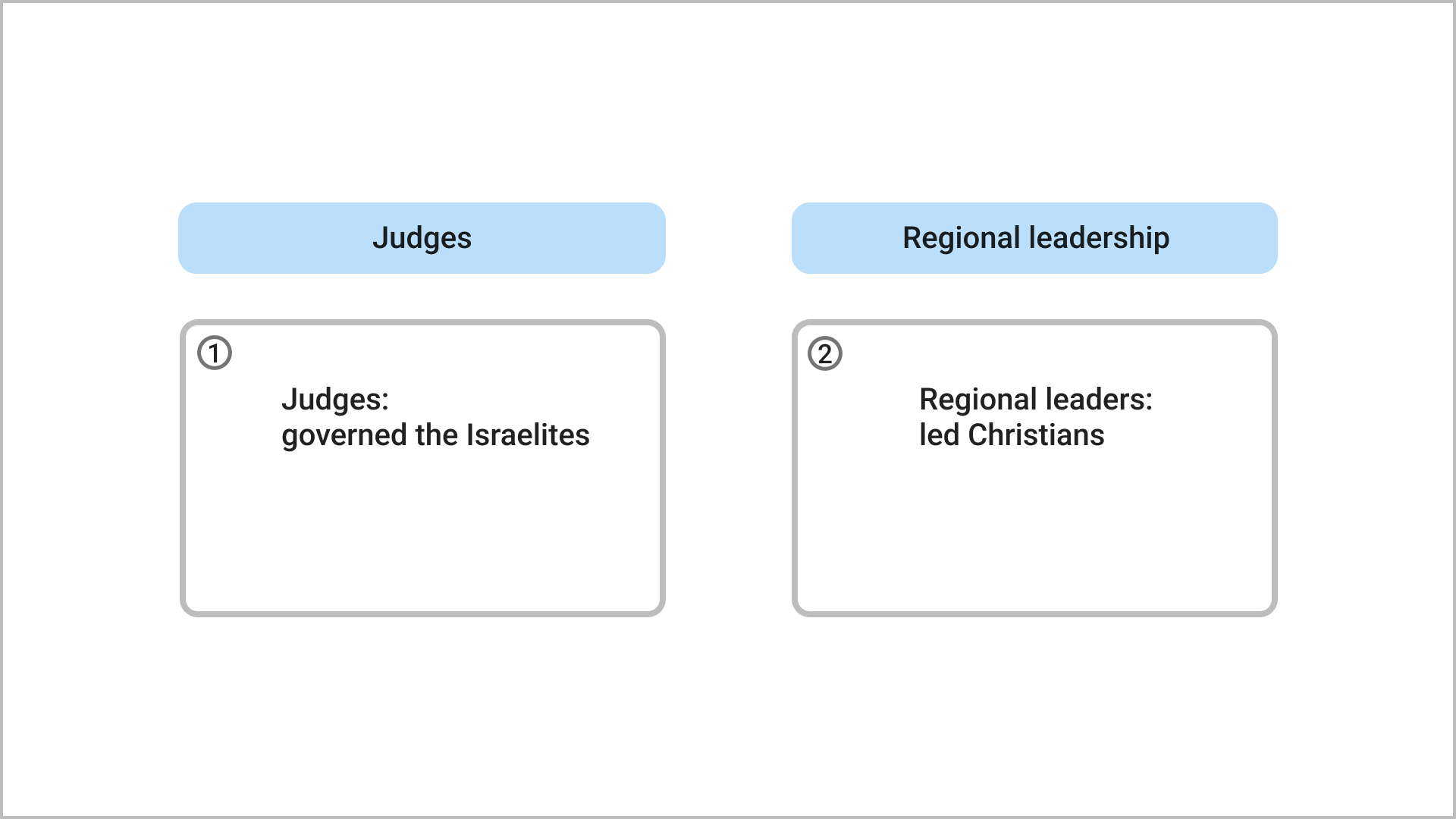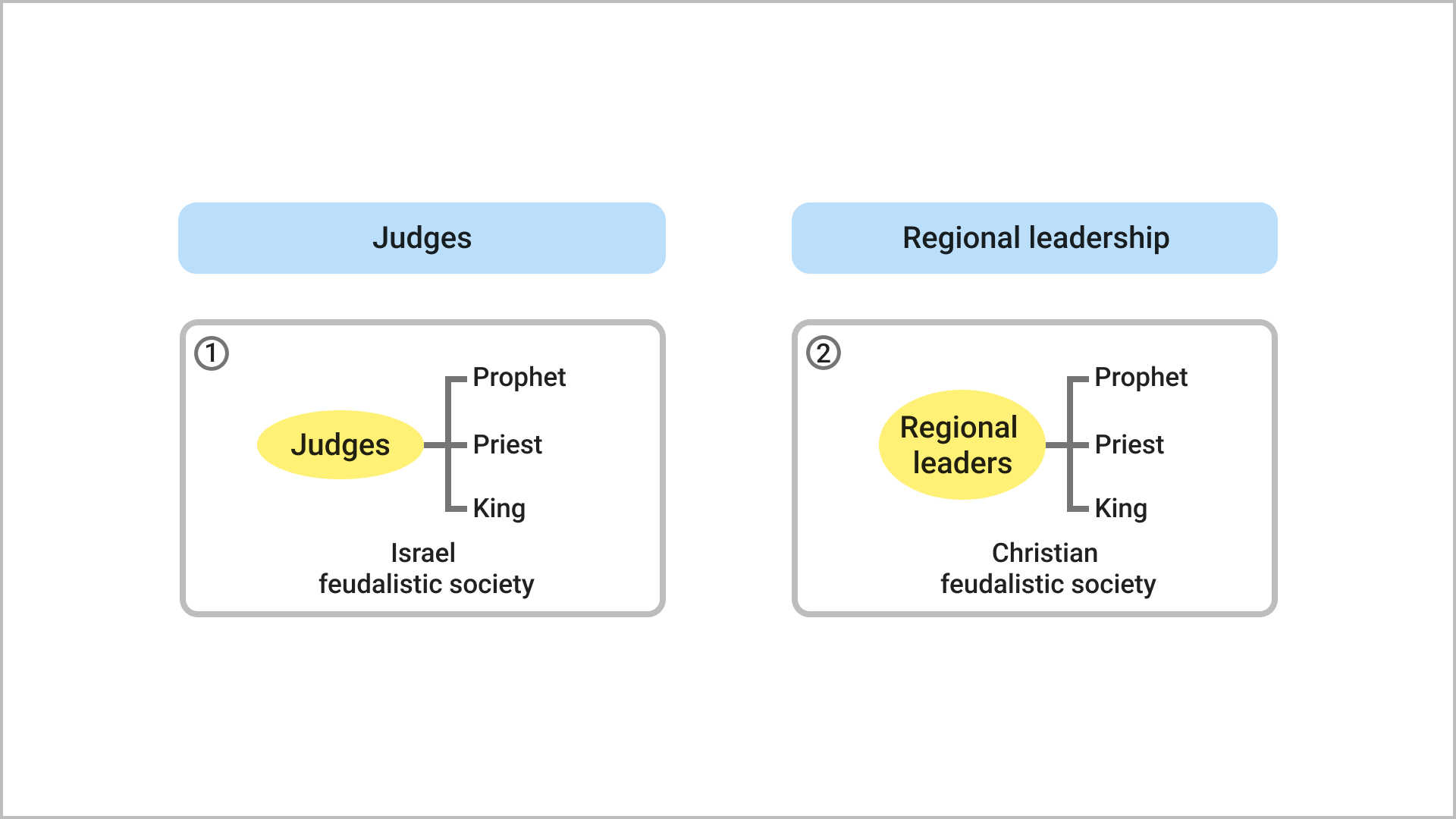모세의 사명을 계승한 여호수아가 이스라엘 선민을 인도하여 가나안 땅에 들어간 후, 옷니엘 사사(士師)를 위시한 12사사에 이어 삼손, 엘리, 사무엘에 이르기까지 도합 15사사가 이스라엘을 지도하였던 400년 간을 사사시대(士師時代)라고 한다. 그들 사사는 다음 시대에 있어 분담된 예언자(豫言者)와 제사장(祭司長)과 국왕(國王)의 사명을 겸임하고 있었다. 그러므로 유대교의 봉건사회(封建社會)는 이때부터 시작되었던 것이다. 이러한 사사시대를 실체적인 동시성으로 탕감복귀하는 시대였던 신약시대(新約時代)의 교구장제 기독교회시대(敎區長制基督敎會時代)에 있어서도, 역시 교구장들은 기독교 신도들을 영도(領導)하는 면에 있어 사사의 그것에 해당하는 직분을 띠고 있었다.
Upon inheriting the mission of Moses, Joshua led the Israelites into the land of Canaan. For the next four hundred years, fifteen judges governed the Israelite tribes: thirteen judges from Othniel to Samson recorded in the Book of Judges, as well as Eli and Samuel. The judges filled the various responsibilities of prophet, priest and king, which became separate offices in the later periods. Israel in this period was a feudalistic society with no central political authority. In the New Testament Age, the period of regional church leadership was set up to restore the period of the judges through parallel indemnity conditions. In this period, regional church leaders – patriarchs, bishops and abbots – led Christian society. Like the judges of the Old Testament Age, they had duties similar to those of prophet, priest and king. As in the time of the judges, Christian society in this period was a feudalistic society under these local authorities.

예수 이전의 시대에는 제1 이스라엘을 중심하고 영육(靈肉) 아울러 ‘메시아를 위한 기대’를 조성해 나아갔었기 때문에, 정치와 경제와 종교는 하나의 지도자 밑에 통솔되어 나아갔었다. 그러나 예수님 이후의 노정은 이미 조성된 ‘메시아를 위한 영적 기대’ 위에서 영적인 만왕의 왕 되신 예수님을 중심하고 영적인 왕국을 건설해 나아가게 되었기 때문에, 신약시대에 있어서의 제2 이스라엘에 의한 기독교계는 부활하신 예수님을 왕으로 모신 하나의 국토 없는 영적인 왕국인 것이다.
In the age before Jesus, when God was working with the First Israel to establish a national foundation for the Messiah both spiritually and physically, politics, economy and religion tended to have a national focus. On the other hand, in the age after Jesus, Christians were building a spiritual kingdom under the leadership of Jesus, who stood upon the spiritual foundation for the Messiah. Their loyalty transcended national barriers, for they were serving the resurrected Jesus as the King of Kings.
교구장(敎區長)은 이러한 영적 왕국 건설에 있어서 사사(士師)와 같은 사명을 가지고 있었기 때문에 때로는 예언자도 되어야 했고, 때로는 제사장의 역할도 해야 했으며, 때로는 교구를 통치하는 국왕과 같은 사명도 해야 했던 것이다. 따라서 기독교봉건사회(基督敎封建社會)는 이때부터 시작되었다.
Therefore, the spiritual kingdom of Jesus was not confined to any one nation, but expanded to the far-flung corners of the globe.
사사시대에 있어서는, 사탄세계인 애급(埃及)에서 출발한 이스라엘 민족은 모두 광야에서 쓰러지고 거기에서 출생한 그들의 후손들만이 오직 남아진 여호수아와 갈렙의 인도함을 따라 가나안 복지(福地)에 들어간 후에, 각 지파에게 분배된 새 땅에서 사사를 중심하고 새로운 선민(選民)을 형성하여 이스라엘 봉건사회의 기틀을 잡았던 것이다. 마찬가지로 교구장제 기독교회시대(敎區長制基督敎會時代)에 있어서도 기독교는 사탄세계인 로마제국에서 해방된 후, 4세기에 몽고족(蒙古族)의 일파인 훈족의 서침(西侵)에 의하여 서구로 이동된 게르만 민족에게 복음을 전파함으로써, 서구의 새 땅에서 게르만 민족을 새로운 선민으로 세워 기독교봉건사회(基督敎封建社會)의 기틀을 형성하였던 것이다.
The period of the judges began after the Israelites were liberated from slavery in Egypt and the younger generation united solidly under the leadership of Joshua and Caleb to enter the land of Canaan. They parceled out the territory among their clans and tribes. Settling in villages united around the judges, the people consolidated into a chosen nation and established a simple feudalistic society. Likewise, the period of regional church leadership in the Christian era began after the liberation of Christianity from the persecution of the Roman Empire, the satanic world. Christians spread the Gospel to the Germanic peoples, many of whom had migrated to Western Europe in the fourth century to escape the invading Huns. In their new land of Western Europe, God raised up the Germanic tribes as a new chosen people and established an early form of feudal society, which later matured into the feudalism of the Middle Ages.

애급(埃及)을 떠난 이스라엘 민족의 가나안 복귀노정에서, ‘실체기대(實體基臺)’를 이루기 위하여 성막(聖幕)을 메시아의 상징체인 동시에 아벨 대신의 조건물로 세웠었다는 사실은 이미 모세를 중심한 복귀섭리에서 상론(詳論)한 바이다. 그러므로 사사시대(士師時代)에 있어서의 이스라엘 민족은 사사(士師)들의 지도를 따라 성막의 뜻만을 받들어야 할 것이었는데, 이들은 가나안 7족을 멸하지 않고 그대로 남겨 둠으로써 그들로부터 악습을 받아 우상(偶像)을 섬기게 되었기 때문에 그들의 신앙에 큰 혼란을 가져왔었다. 마찬가지로 교구장제 기독교회시대에 있어서도 기독교 신도들은 교구장의 지도를 따라 메시아의 형상체인 동시에 아벨 대신의 조건물인 교회의 뜻만을 받들어야 할 것이었는데, 그들은 게르만 민족으로부터 잡도(雜道)의 영향을 받았기 때문에 그들의 신앙에 큰 혼란을 가져오게 되었던 것이다.
As we discussed earlier, when the Israelites set out for Canaan, they first built the Tabernacle as the symbol of the Messiah and the object for the condition to decide who would stand in the position of Abel for the foundation of substance (cf. Moses and Jesus 2.2.2.3). In the period of the judges, the Israelites should have exalted the Tabernacle and remained obedient to the direction of the judges. However, instead of destroying the seven Canaanite tribes, the Israelites lived among them and were influenced by their customs. They even took to worshipping their idols, thus bringing great confusion to their faith. Likewise, in the period of regional church leadership, the Christians were supposed to exalt the Church, which was the image of the Messiah, and follow the directions of its bishops and monastic leaders. The Church was the object for the condition to determine who would have the position of Abel. However, they became influenced by the religion and culture of the pagan Germanic tribes, which brought great confusion to the Christian faith.